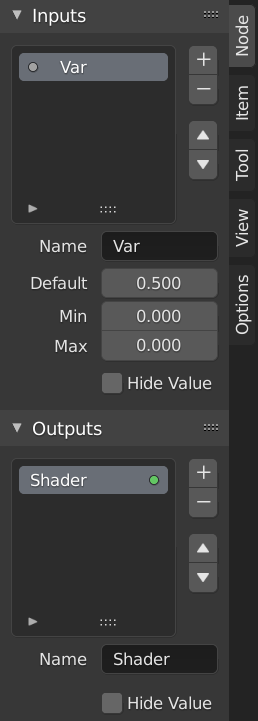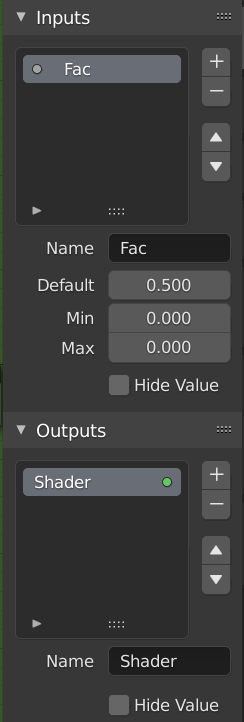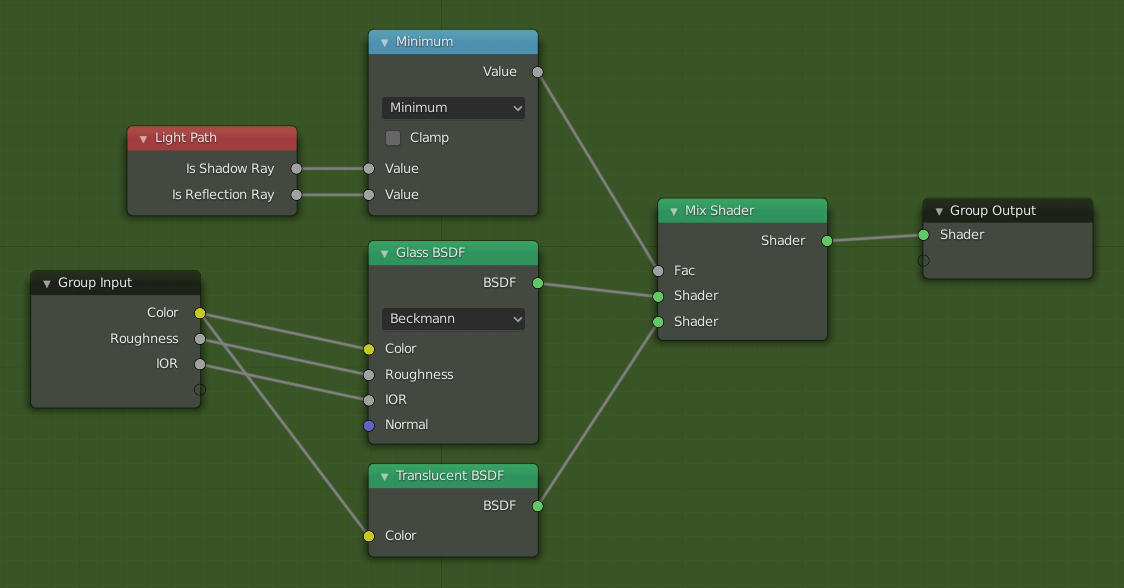Groupe de nœuds¶

Exemple de groupe de nœuds.¶
Grouping nodes can simplify a node tree by allowing instancing and hiding parts of the tree.
Conceptually, grouping nodes allows you to specify a set of nodes that you can treat as though it were « just one node ». Node groups are similar to functions in programming, they can be reused in many places in a node tree and can be customized by changing the « parameters » of the node group.
As an example: If you have created a material that you would like to use with different inputs e.g. diffuse color: red plastic, green plastic. You could create different materials with Make Single User for each different color with a copy of the tree part describing the plastic material. If you like to edit the material you would need to redo the edit on all materials. A better method of reuse is to create node groups, exposing only the variable inputs (e.g. diffuse color).
Also nested node groups are supported. I.e. a node group can be inserted or created inside another node group.
Note
Les groupes de nœuds récursifs sont interdits pour tous les systèmes de nœuds actuels afin d’éviter une récursivité infinie. Un groupe de nœuds ne peut jamais se contenir (ou un autre groupe qui le contient).
Interface¶
Lorsqu’un groupe de nœuds est créé, de nouveaux nœuds Group Input et Group Output sont générés pour représenter le flux de données entrant et sortant du groupe. De plus, les connexions aux prises d’entrée provenant de nœuds non sélectionnés seront attachées à de nouvelles prises sur le nœud Group Input. De même, les connexions sortantes vers des prises d’entrée de nœuds non sélectionnés seront rattachées au nouveau nœud Group Output.
If you want to pass an additional parameter into the group, a socket must be added to the Group Input node. Therefore drag a connection from the hollow socket on the right side of the Group Input node to the desired input socket on the node requiring an input. The process is similar for the Group Output regarding data you want to be made available outside the group.
Panneau¶
Référence
- Mode
Tous Modes
- Panneau

Le panneau d’interface pour l’édition des groupes.¶
Sockets can be added, re-ordered, or removed, descriptive names can be added and the details of the input data value defined here.
If you have multiple inputs or outputs, they can be re-ordered by selecting the socket in the list. And then moving them up or down with the arrow buttons on the right side of the panel. The plus button will add an unconnected socket of the same type as the selected socket or a value socket if there is no selection. The minus button will remove the selected socket. The triangle at the bottom of the list has filtering functions to help finding nodes if the group has a large number of sockets.
- Name
Le nom du socket à afficher dans l’interface du nœud.
- Tooltip
The message displayed when hovering over socket properties. Currently only supported for Geometry Node Editor
- Default
The value to use when nothing is connected to the node socket. Note, this will not affect the current node but will affect instances of the node.
- Min, Max
The minimum and maximum value for the UI button shown in the node interface. Note, this is not a minimum or maximum for the data that can pass through the node. If a socket passes a higher value than the maximum it will still pass into the node unchanged.
- Hide Value
Masque la valeur du socket même lorsque celui-ci n’est pas connecté.
Edit Group¶
Référence
- Mode
Tous Modes
- Menu
- Entête
- Raccourci
Tab, Ctrl-Tab
With a node group selected, Tab expands the node to a frame, and the individual nodes within it are shown. You can move them around, play with their individual controls, re-thread them internally, etc. just like you can if they were a normal part of the editor view. You will not be able, though, to thread them to a node outside the group; you have to use the external sockets on the side of the node group. While Tab can be used to both enter and exit a group, Ctrl-Tab only exits.

Exemple de groupe de nœuds développé.¶
Créer un groupe¶
Référence
- Mode
Tous Modes
- Menu
- Raccourci
Ctrl-G
To create a node group, select the nodes you want to include, then press Ctrl-G, . A node group will have a green title bar. All selected nodes will now be contained within the node group. Default naming for the node group is « NodeGroup », « NodeGroup.001 » etc. There is a name field in the node group you can click into to change the name of the group. Change the name of the node group to something meaningful.
Lorsque vous ajoutez des groupes de nœuds d’un fichier blend à un autre, Blender ne fait pas de distinction entre les groupes de nœuds de matériaux ou les groupes de nœuds composites, il est donc recommandé d’utiliser une certaine convention de dénomination qui vous permettra de distinguer facilement les deux types.
Astuce
What not to include in node groups:
Remember that the essential idea is that a group should be a reusable, self-contained software component. Material node groups should not include:
- Input nodes
If you include a source node in your group, you will end up having the source node appearing twice: once inside the group, and once outside the group in the new material node tree.
- Output node
If you include an output node in the group, there will not be an output socket available from the group!
Dégrouper¶
Référence
- Mode
Tous Modes
- Menu
- Raccourci
Ctrl-Alt-G
The Ctrl-Alt-G tool removes the group and places the individual nodes into your editor workspace. No internal connections are lost, and now you can link internal nodes to other nodes in your workspace.
- Separate P
Sépare les nœuds sélectionnés du groupe de nœuds.
- Copy
Copie dans l’arborescence des nœuds parent, conserve le groupe intact.
- Move
Déplace vers l’arborescence des nœuds parent, supprime du le groupe.
Group Insert¶
Référence
- Mode
Tous Modes
- Menu
Sélection d’un ensemble de nœuds, se terminant par le nœud du groupe de destination et en appuyant sur déplacera ces nœuds dans ce groupe. Les nœuds déplacés sont rassemblés dans un groupe qui leur est propre pour préserver leur contexte de connexion, ayant leurs propres nœuds d’entrée et de sortie de groupe. Les nœuds d’entrée et de sortie existants du groupe sont mis à jour avec de nouveaux sockets, le cas échéant, à partir des nouveaux nœuds. Le groupe de nœuds doit être modifié pour contenir une seule entrée de groupe et un seul nœud de sortie de groupe.
Appending Node Groups¶
Référence
- Éditeur
Topbar
- Mode
Tous Modes
- Menu
Once you have appended a Node Tree to your blend-file, you can make use of it in a node editor by pressing Shift-A, , then selecting the appended group. The « control panel » of the Group include the individual controls for the grouped nodes. You can change them by working with the Group node like any other node.